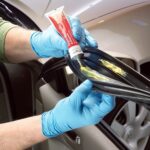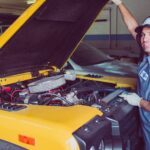Navigating the complexities of sales tax can be challenging, especially when it comes to auto repairs. If you’ve recently received a bill for car repairs, particularly one around $1978.00, you’re likely wondering about the sales tax implications. This article breaks down the essential aspects of sales tax on auto repairs, focusing on how it applies to parts and labor, and what you need to understand to ensure you’re paying the correct amount. We’ll delve into the regulations that govern these charges, helping you become an informed consumer when it comes to auto repair expenses and associated taxes.
California Sales Tax Regulations for Auto Repair: A Detailed Overview
California, like many states, has specific regulations regarding sales and use tax, and these rules directly impact the auto repair industry. Understanding these regulations is crucial for both consumers and auto repair businesses to ensure compliance and accurate billing. The core of these regulations lies in distinguishing between parts and labor and determining when sales tax applies to each.
Retailer vs. Consumer: The Key Distinction for Parts and Materials
In auto repair, a fundamental concept is whether the repair shop is acting as a retailer or a consumer of the parts they use. This distinction determines how sales tax is applied. According to California’s Sales and Use Tax Regulation 1546, a repairer acts as a retailer if the retail value of parts and materials furnished in connection with repair work is more than 10 percent of the total charge, or if they make a separate charge for these parts. In this case, the repair shop is responsible for collecting sales tax on the fair retail selling price of the parts.
Conversely, if the retail value of parts and materials is 10 percent or less of the total charge, and no separate charge is made for these parts, the repair shop is considered the consumer of the property. In this scenario, the repair shop pays sales tax when they purchase the parts from their supplier, and they do not charge sales tax to the customer on these parts.
The 10 Percent Rule: How It Impacts Your Auto Repair Tax
The “10 percent rule” is a critical element in determining sales tax obligations in auto repair. This rule dictates whether the repair shop should charge you sales tax on the parts they used in your car repair. To understand this, consider your $1978.00 auto repair bill. The total charge includes both parts and labor. If the retail value of the parts exceeds 10% of this $1978.00, then the repair shop must charge sales tax on those parts.
For example, if your $1978.00 bill includes $300 in parts, we need to calculate 10% of $1978.00, which is $197.80. Since $300 (parts cost) is more than $197.80 (10% of total charge), the repair shop is acting as a retailer and must charge sales tax on the $300 worth of parts. However, if the parts were only $150, which is less than $197.80, and no separate charge is made, then the repair shop is considered the consumer, and sales tax is not charged to you directly on the parts.
Segregation of Parts and Labor on Invoices: Transparency is Key
To ensure clarity and compliance, California regulations require repair shops to provide detailed invoices. Specifically, if the repair shop is acting as a retailer of parts (because the parts value exceeds the 10% threshold or they are separately charged), they must segregate the fair retail selling price of parts and materials from the charges for labor on the invoice. This segregation allows customers to clearly see the basis for sales tax charges.
According to Section 9884.8 of the Business and Professions Code, automotive repair dealers must list service work and parts separately on the invoice. The invoice should also state subtotal prices for service work and parts (excluding sales tax) and separately state the sales tax applicable to each. This level of detail ensures transparency and helps customers understand how their total bill is calculated, including the sales tax component.
Maintenance Contracts and Sales Tax: Lump-Sum Agreements
Sales tax rules can also apply to maintenance contracts. California regulations differentiate between mandatory and optional maintenance contracts. A mandatory maintenance contract is required as a condition of sale, while an optional contract is not.
If your repair falls under a mandatory lump-sum maintenance contract that covers parts, materials, and labor, the repairer is considered the retailer of the materials furnished. Therefore, if the original sale of the property being maintained was taxable, the amount charged for the maintenance contract is also subject to sales tax, even if stated separately. Conversely, under an optional lump-sum maintenance contract, the repairer is generally considered the consumer of the parts and materials.
Insurance Covered Repairs and Bid Modifications
In cases where insurance covers the auto repair, sales tax is still applicable based on the same principles. When a repair shop provides a bid that is accepted, the sales price of parts in that bid is the taxable measure. However, bids can be modified. If there are changes to the repair plan, and consequently to the parts used, the repair shop can modify the original bid agreement. For this modification to be valid for tax purposes, the customer or the insurer must be informed of the change, and ideally, the modified bid should be in writing, especially if the original bid was written. The final invoice should reflect the actual parts used and their sales price, which forms the basis for sales tax calculation.
Applying the Regulations to Your $1978.00 Auto Repair Bill
To determine the sales tax on your hypothetical $1978.00 auto repair bill, you need to examine the invoice closely.
- Check for Segregation: Does the invoice clearly separate charges for parts and labor? If so, this is a good sign of compliance.
- Identify Parts Value: Find the total retail value of the parts listed on the invoice.
- Calculate 10% Threshold: Calculate 10% of the total bill amount ($1978.00 * 0.10 = $197.80).
- Compare Parts Value to Threshold: Is the retail value of parts greater than $197.80?
- If YES: Sales tax should be charged on the parts value. Verify that sales tax is applied only to the parts subtotal and not the entire $1978.00.
- If NO: Sales tax should generally not be charged directly to you on the parts, unless there is a separate charge for parts regardless of the 10% rule.
Example Scenario:
Let’s say your $1978.00 invoice breaks down as follows:
- Parts: $600.00
- Labor: $1378.00
- Subtotal: $1978.00
- Sales Tax (on Parts): $45.00 (Assuming a 7.5% sales tax rate)
- Total: $2023.00
In this case, since $600 (parts) is significantly more than 10% of $1978.00 ($197.80), it is correct for the repair shop to charge sales tax on the $600 of parts. The labor portion is not subject to sales tax in California.
Conclusion: Understanding Auto Repair Sales Tax for Informed Decisions
Understanding the nuances of sales tax on auto repairs empowers you to review invoices with confidence and ensure accurate billing. The “10 percent rule,” the segregation of parts and labor on invoices, and the distinction between retailer and consumer are key concepts to grasp. When you receive your next auto repair bill, especially one around $1978.00 or any significant amount, take a moment to review it against these guidelines. By being informed about these regulations, you can effectively manage your auto repair expenses and understand the sales tax component accurately. This knowledge not only helps in personal finance but also promotes transparency and fairness in your interactions with auto repair businesses.


